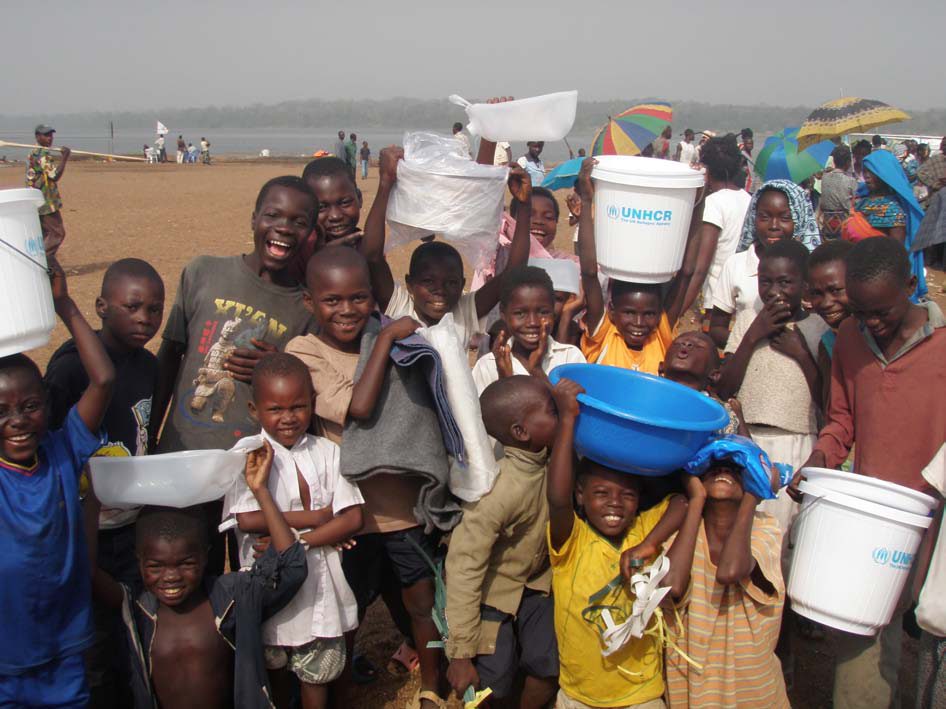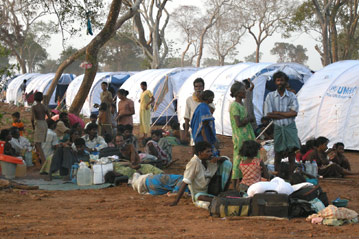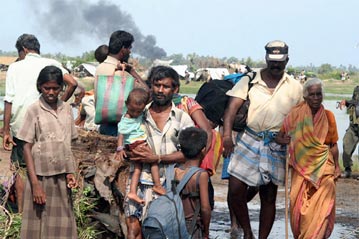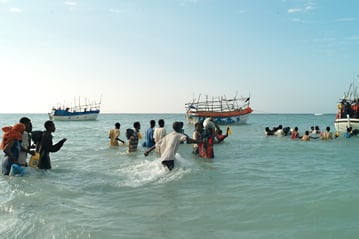Tsunami survivors face grim task of rebuilding lives
Tsunami survivors face grim task of rebuilding lives
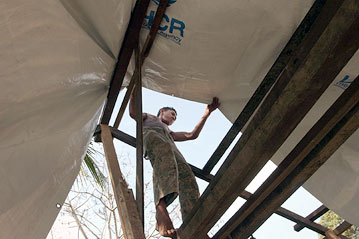
MEULABOH, Indonesia, Jan 27 (UNHCR) - Sulaiman's eyes misted as he received blankets, plastic sheeting and kitchen sets from the UN refugee agency for his extended family of 25 crammed into an abandoned housing project in Meulaboh city.
A proud man, he recounted the eight houses by the sea he had built for his seven children, their spouses and grandchildren. He had been engaged in the lucrative business of buying and selling commodities.
"With the sudden turn of fortune, I have become a poor man," said Sulaiman, referring to the devastating earthquake and tsunami that flattened his village of Padang Sirahet near the Meulaboh harbour the morning after Christmas.
"I have nothing except the clothes I have on," he said, touching his sleeveless cotton singlet shirt and sarong, the wrap-around skirt Indonesian men favour to ward off the intense humid heat of the mid-day sun.
Still, he considers himself lucky. He and his family were all on their way to attend the wedding of his brother's son and watched safely from a distance as the tsunami ripped through the west coast of Aceh province in Indonesia's island of Sumatra.
He was later told that the mother of the groom perished in the tsunami that claimed between 95,000 and 100,000 lives in Indonesia alone. Another 133,000 people are still missing.
Sulaiman and his family fall into one of three categories of displaced persons estimated at around 150,000 in the tsunami-wasted Aceh region: affected people who used to live along the coast outside the so-called "green line" where rebuilding is not allowed because of its proximity to the sea.
Another category comprises people who have land but whose houses have been completely destroyed. These are people like 60-year-old Burhan. All that remains of what this coconut farmer calls home is a slab of concrete flooring. He has scavenged wood from the debris in his village outside Meulaboh and has erected an A-frame, over which he has put a UNHCR plastic sheet for a roof.
On the sunny eve of the Moslem holiday Eid Al-Adha, Burhan and his family of seven were trying to complete a one-room house so they could move out of the nearby mosque that has sheltered them since the tsunami struck.
A third category includes those whose stone houses weathered one of the world's worst natural disasters. They were partly damaged and could easily be repaired.
Most of the displaced people live with host families, mainly relatives and friends.
The government last week announced the demarcation of areas where rebuilding would be allowed but gave no details of the green line. Some authorities mentioned an area 500 metres from the coastline.
Representatives of UN agencies and aid organisations agreed on the categorisation of the tsunami victims in an attempt to identify the requirements of each group. "Each of the victims has different needs and so we decided to put together a package of assistance for each category," says UNHCR's Jette Gottlieb, a veteran worker in refugee emergencies from Bosnia to Afghanistan.
UNHCR coordinates shelter activities in the hard-hit Meulaboh region. "Some people, for example, need only nails and hammers," says Gottlieb.
One month after the disaster, Indonesian authorities and aid workers declared that the emergency phase of relief work is practically over, but the more critical tasks of recovery and rehabilitation remain. Indonesian military and civilian authorities have made substantial progress in clearing debris in many areas of the ruined coast. In many areas, life is coming back to normal with shops and restaurants reopening.
"Provision of shelter is top priority in the days ahead," says Alan Vernon, head of UNHCR's emergency team in the disaster zone. "This is where we hope we will make a difference - in finding solutions for those displaced."
As reports unfolded of the enormity of the devastation the tsunami brought from Indonesia to Somalia, UNHCR mounted its first major response to a natural disaster as part of the UN family. This followed a call by UN Secretary-General Kofi Annan to UNHCR to contribute its expertise and resources to the UN effort.
UNHCR's core mandate is helping refugees - people fleeing persecution and violence. It has made an appeal for $75 million for its operations for six months - including $60 million for temporary and longer-term shelter needs for up to 175,000 people in Indonesia.
Within hours of the tsunami rampage, UNHCR distributed non-food relief items from its warehouses in Sri Lanka for victims of the disaster there. UNHCR has been in Sri Lanka for two decades helping people displaced by the conflict.
But in Indonesia, UNHCR started from scratch. Staff members were deployed to the Aceh region and 400 tons of relief supplies, including 2,000 tents, were airlifted from its central warehouses in Dubai and Copenhagen.
With the dispatch by the Swiss government a week ago of three Puma helicopters to the UNHCR relief effort, its workers began distributing aid to affected families in previously inaccessible areas along the west coast.
In Meulaboh, UNHCR has been handing out plastic sheeting, blankets, jerry cans and kitchen sets to displaced people. Following a request by the Indonesian government to ease appalling conditions in camps for the homeless tsunami victims, UNHCR is building its first camp for the displaced in Meulaboh.
The camp at Lehang village near the city centre uses exclusively UNHCR's newly designed lightweight polyester tents. It will house around 170 families when completed by the end of the week after its partner, Oxfam, completes construction of latrines and water facilities. The camp will be run by Indonesian authorities.
UNHCR is also looking at other relocation sites within Meulaboh and its surrounding villages.
Some overseas media reports have raised the possibility of "forced relocation" in a mineral-rich area where the Indonesian government is fighting a separatist insurgency.
"We have seen no indication of forced relocation," says UNHCR's Ghassem Fardanesh. "The fury of nature handpicked its victims at random. If international standards are to be set in the encampments, relocation obviously needs to take place."
Solution must be found for people like Sulaiman, whose 25 family members will have to live in the abandoned housing project that had the sky as its roof until UNHCR gave it a plastic cover.
"My property has been swallowed by the sea. It is impossible to go back there now," says Sulaiman.
By Fernando del Mundo in Meulaboh, Indonesia

